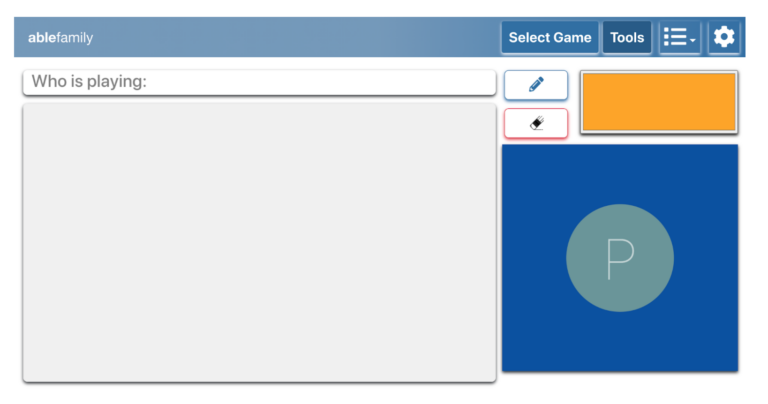The Able Project Series (2016-2021)
The Able project series is derived from the Body Editing research series, and has evolved in three key iterations: Able rehab, Able Music and the current iteration, available on line, ABLE.Family. Our aim is to understand older adults’ mobility, wellness and activity goals and build technologies with and for them so that they can do the things that they value as they age. We uniquely engage art-based practice, following research showing a synergistic effect in experiences blending art and play, socialization, and movement, which benefits players mood, cognition and physiology. We contribute to this research space, which in fact has little research documenting these benefits of these synergies offered via activities and technologies.
In order to conduct interdisciplinary research our team includes artist/designers, critical theorists, gerontologists and physical and occupational therapists, engineers and computer scientists. As well, our approaches are informed by critical ageing, dementia and disability (and ‘crip’) research, that centers individuals with lived experience as key designers and problem solvers. In our iterative design approach, we rapidly prototype and seek to “break” our technology, to move closer to a design approved by our stakeholders. In each iteration, we engage in rigorous participatory and co-design with stakeholders including older adults with dementia and frailty, long term care homes, and advocacy and service groups including the Alzheimer Society of Hamilton and Halton, including their Minds in Motion Program. As the documentation shows, the iterations had different aims but used similar approaches and technologies.
All those efforts culminated in ABLE.Family, re-designed during the COVID-19 pandemic to support remote, playful activities for older adults with dementia and their distanced intergenerational family members. The dementia-informed interface and game design strategies relies on user’s long term memory, is accessibly designed, and exploits procedural learning (so that older adults can return and know how to play despite having memory issues. It also offers a range of sensory (textural, colour) and cognitive game options to meet the interests of diverse older adults with dementia and their differently aged family members. The interface design includes a “less busy” version to support the cognitive needs of older adults with dementia and includes an in-game video conferenceing feature enabling family members to support older adults playing with them, and to allow in-house caregivers to step away from the computer to take much needed respite. We are currently working on the next iteration, that includes music and movement activities, including dance and Tai Chi. A downloadable handbook helps families to navigate game features. The free app is available at ableplatform.ca. The ABLE manual can be viewed here.
Research Team
Principle Investigator: Dr. Paula Gardner, Asper Research Chair in Communications, Department of Communication Studies and Media Arts
Dr. Caitlin McArthur: Assistant Professor, Physical Therapy, Dalhousie University
Dr. Rong Zheng: Professor, Department of Computing and Software, Faculty of Engineering
Project Coordinator and Creative Technologist: Stephen Surlin, PhD Candidate in Communications, New Media and Cultural Studies, McMaster University
Research Assistant: Adekunle Akinyemi, MEng, Engineering Entrepreneurship and Innovation, Faculty of Engineering
Researcher: Jessica Rauchberg, PhD Candidate in Communications, New Media and Cultural Studies, McMaster University
Research Assistant: Yujiao Hao, PhD Candidate, Department of Computer and Software department, Faculty of Engineering

The Able.Family game is live at ableplatform.ca. As noted in the Body Editing Portfolio you can sign on by creating a game room, and adding your name. Invite friends to sign onto that room, select a game, and ti will appear for all to play. The site is dementia-informed an user friendly. Consult the game manual below or on the platform site for more guidance.
Writing
Able manual https://www.ableplatform.ca/assets/ableusermanual.pdf
Smith, A., MacArthur, C., Belgrave Sookhoo, J., Gardner, P., Papaioannou, A., Zheng, R., Surlin, S., & Akinyemi, A. (2021). “Think of it like a game”: The perspectives of older adults and health professionals on interactive exercise technology design. Physiotherapy Canada 0:00 (Advance Online Article) (10 published pages) doi: 10.3138/ptc-2019-0115.
Gardner, P., Surlin, S., Akinyemi, A. Rauchberg, J., McArthur, C., Zheng, R. Hao, Y. & Papaioannou, A. (2020). ABLE music: Arts–Based exercise enhancing LongEvity in Elders. In C. Stephanidis, M. Antona & S. Ntoa S. (Eds.), Communications in Computer and Information Science, vol 1294 (pp. 450–454). Springer, Cham. HCI International 2020 – Late Breaking Posters.
Gardner, P., McArthur, C., Akinyemi, A., Surlin, S. Zheng, R., Papaioannou, A., Hao, Y. & Xu, J. (2019). Employing interdisciplinary approaches in designing with fragile older adults: Advancing ABLE for Arts–based rehabilitative play and complex learning. In J. Zhou & G. Salvendy (Eds.), Communications in Computer and Information Science; Human Aspects of IT for the Aged Population. Design for the Elderly and Technology (pp. 1–19). Springer, Cham. doi: 10.1007/978–3–030–22012–9_1.
Gardner, P., Surlin, S. & McArthur, C. (2018). ABLE: An arts–based, interactive physical therapy platform for seniors with dementia and frailty. In C. Stephanidis et al (Eds.), HCI International– Posters’ Extended Abstracts. Communications in Computer and Information Science, vol 851 (pp 141-48). Springer, Cham.